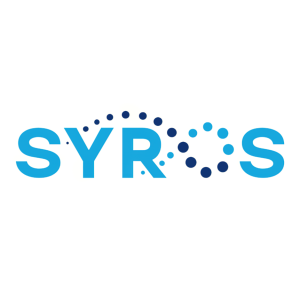Syros Pharmaceuticals Announces Publication in Blood Advances Demonstrating the Potential of Tamibarotene in Patients with RARA Gene Overexpression, Supporting Ongoing Clinical Development in AML and MDS
Syros Pharmaceuticals announced promising results from a Phase 2 trial of tamibarotene combined with azacitidine for treating newly diagnosed, unfit acute myeloid leukemia (AML) patients with RARA overexpression. The trial showed a high complete response (CR) rate of 50% and an overall response rate (ORR) of 67% among those with RARA overexpression. The treatment was generally well tolerated, with no significant added toxicity. Syros is advancing to Phase 3 and Phase 2 trials to further evaluate tamibarotene in myelodysplastic syndrome (MDS) and AML.
- High complete response (CR) rate of 50% and overall response rate (ORR) of 67% in AML patients with RARA overexpression.
- Rapid onset of response with a median time to complete remission of 1.2 months.
- Combination treatment was generally well tolerated with comparable side effects to azacitidine alone.
- Only 30% of AML patients and 50% of high-risk MDS patients are eligible based on RARA overexpression, limiting market potential.
Combination of tamibarotene and azacitidine in a Phase 2 trial demonstrated a high complete response rate, with rapid onset and clinically meaningful durability in newly diagnosed unfit acute myeloid leukemia (AML) patients with RARA overexpression
Targeting RARA overexpression with tamibarotene is a novel targeted approach in newly diagnosed AML and MDS patients with potential to provide new frontline standards-of-care
Currently evaluating tamibarotene in Phase 3 SELECT-MDS-1 trial and Phase 2 SELECT-AML-1 trial; initial data from SELECT-AML-1 presented at 64th ASH Annual Meeting on
“We are excited to see a high CR rate and a rapid onset of response in newly diagnosed unfit AML patients with RARA overexpression treated with a combination of tamibarotene plus azacitidine. The biomarker test successfully identified AML patients positive for RARA overexpression who were enriched for response to tamibarotene and azacitidine relative to those patients who were negative for RARA overexpression. This observation further demonstrates that the activity of tamibarotene is dependent on the biology of RARA overexpression. In addition, the combination was generally well tolerated and provides the potential for a novel targeted treatment approach for patients with AML,” said
“With approximately
In the SY-1425-201 trial, a total of 51 patients at 12 sites in the
A total of 18 patients with RARA overexpression were response evaluable and exhibited an overall response rate (ORR) of
Importantly, the tamibarotene plus azacitidine combination was generally well tolerated in the patients treated. The rates of myelosuppression were comparable to azacitidine monotherapy in this population suggesting no added hematologic toxicity from tamibarotene when used in combination with azacitidine. The majority of non-hematologic adverse events (AEs) were low grade.
About
Syros is redefining the power of small molecules to control the expression of genes. Based on its unique ability to elucidate regulatory regions of the genome, Syros aims to develop medicines that provide a profound benefit for patients with diseases that have eluded other genomics-based approaches. Syros is advancing a robust clinical-stage pipeline, including: tamibarotene, a first-in-class oral selective RARα agonist in patients with higher-risk myelodysplastic syndrome and acute myeloid leukemia with RARA gene overexpression; SY-2101, a novel oral form of arsenic trioxide in patients with acute promyelocytic leukemia; and SY-5609, a highly selective and potent oral CDK7 inhibitor in patients with select solid tumors. Syros also has multiple preclinical and discovery programs in oncology and monogenic diseases. For more information, visit www.syros.com and follow us on Twitter (@SyrosPharma) and LinkedIn.
Cautionary Note Regarding Forward-Looking Statements
This press release contains forward-looking statements within the meaning of The Private Securities Litigation Reform Act of 1995, including without limitation statements regarding Syros’ clinical development plans, including with respect to the progression of its clinical trials involving tamibarotene and Syros’ ability to deliver benefit to patients and develop new frontline standards-of-care. The words “anticipate,” “believe,” “continue,” “could,” “estimate,” “expect,” “hope,” “intend,” “may,” “plan,” “potential,” “predict,” “project,” “target,” “should,” “would,” and similar expressions are intended to identify forward-looking statements, although not all forward-looking statements contain these identifying words. Actual results or events could differ materially from the plans, intentions and expectations disclosed in these forward-looking statements as a result of various important factors, including Syros’ ability to: advance the development of its programs, including tamibarotene, under the timelines it projects in current and future clinical trials; demonstrate in any current and future clinical trials the requisite safety, efficacy and combinability of its drug candidates; sustain the response rates and durability of response seen to date with its drug candidates; successfully develop a companion diagnostic test to identify patients with the RARA biomarker; obtain and maintain patent protection for its drug candidates and the freedom to operate under third party intellectual property; obtain and maintain necessary regulatory approvals; identify, enter into and maintain collaboration agreements with third parties; manage competition; manage expenses; raise the substantial additional capital needed to achieve its business objectives; attract and retain qualified personnel; and successfully execute on its business strategies; risks described under the caption “Risk Factors” in Syros’ Annual Report on Form 10-K for the year ended
View source version on businesswire.com: https://www.businesswire.com/news/home/20221212005205/en/
Syros Contact
Director of
1-857-327-7321
khunady@syros.com
Media Contact
1-813-767-7801
bleigh@lifescicomms.com
Investor Contact
Stern Investor Relations, Inc.
1-212-362-1200
hannah.deresiewicz@sternir.com
Source:
FAQ
What were the results of the Phase 2 trial for SYRS's tamibarotene?
What is the significance of RARA overexpression in AML?
What are the next steps for SYRS after the trial results?
When were the trial results presented?







